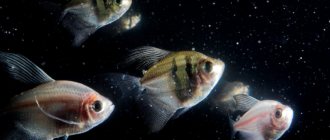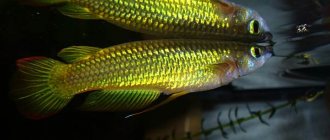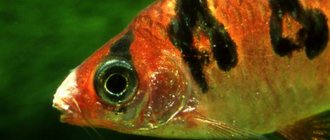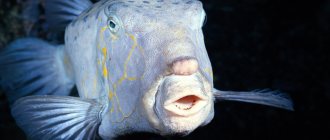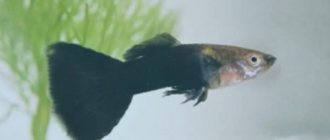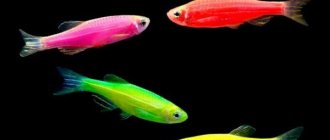It's tempting to imagine yourself owning a tiger shark. But for the ocean beauty you will need a “house” with a volume of over 10 cubic meters. Most citizens are unlikely to find a place for such an aquarium in their homes. And the age of beginning wildlife lovers is usually small. It is unknown whether their hobby will last for a long time or for a few days.
In addition, certain material costs will be required. Therefore, it is better to choose an aquarium of modest size and select small “inhabitants” for it.
The volume of the aquarium determines the number and size of its possible inhabitants, as well as their health. The parameters of the “reservoir” also affect efforts to maintain the required temperature, acidity, water hardness and saturation with oxygen.
Aquariums have a long history. During this time, many species of small aquarium fish were found in nature and were transferred to an artificial habitat.
Breeders have managed to develop a large number of their varieties, differing in shape and color. Recent advances in microbiology and genetics have led to the emergence of so-called nanofish. This is a miniature version of ordinary large fish.
The most common inhabitants of home aquariums
Young aquarists are often advised to start by choosing guppies from the Poeciliidae family. These bright babies with big tails are the most unpretentious and inexpensive of all types of babies. They can eat dry food and do not require water aeration. Males grow up to 3 cm.
Guppies are found in many warm freshwater bodies of water. They are specially bred there to combat malaria mosquitoes. Guppies eat the larvae of these harmful insects.
No less popular species belong to the same family: swordtails and mollies.
Neons (tetra family) can compete for the title as the most popular. They are distinguished by shiny bright stripes on their bodies that sparkle when they move. The birthplace of neon is the Amazon. The maximum length is 4 cm. They prefer live food, live in the middle layers of the reservoir, love cleanliness and space. There should be at least 1 liter of water per individual. Neons are peaceful and get along well in the same aquarium with equally non-aggressive neighbors.
There are also small aquarium fish in the carp family. Easy to keep zebrafish are popular. For their unique color - yellow-green with dark blue stripes - they received affectionate nicknames: “ladies' stockings” and “stripes”. Rivers and streams of Hindustan and northern Indochina are their habitat.
They prefer the upper layers of the aquarium, so they easily combine with lovers of the middle and bottom layers. Due to the biological features of their development, zebrafish have become a kind of laboratory white mice for ichthyologists.
Representatives of this species even participated in space experiments. Breeders have developed a variety of zebrafish with a leopard print color. And more recently, even genetically modified fluorescent fish have appeared.
Other cyprinids include barbs (about 15 species) and dwarf rasboras. These are active, beautiful small aquarium fish that love the middle layers of water. Rasbora crumbs are the smallest of this family. An adult does not grow more than 1.5 cm. All cyprinids get along well in one aquarium.
A little exotic
Representatives of the labyrinthine suborder (order Perciformes) are amazingly structured. They got their name due to the presence of a special organ - a labyrinth, which allows them to saturate the blood with oxygen directly from the atmospheric air.
Such fish are able to live in muddy water and stay on land for a long time. Fans of crossword puzzles are well aware of the name of the most famous of the labyrinth puzzles. This is a climbing perch that can move from one body of water to another during drought.
But when choosing fish for an aquarium, hobbyists prefer to purchase other fish of this suborder - dwarf gourami. A laterally flattened oblong body (3.5-4 cm long) of olive color with a stripe of small dark spots distinguishes these peace-loving fish.
Shy kids love all sorts of caves and shelters. The aquarium in which gouramis live must be covered with a lid so that its inhabitants do not catch a cold. An amazing feature of gourami is its characteristic rather loud rumbling during the spawning period.
Experienced aquarists try to make keeping fish as naturalistic as possible and create a small semblance of a natural biosystem in their reservoir: they settle bottom inhabitants in it. Small catfish are suitable for a small aquarium. They do not interfere with other fish, because they are constantly concerned about the cleanliness of the walls and bottom of the aquarium.
Peaceful, cheerful and active Corydoras are interesting to watch. About 150 species of these catfish are known, native to the rivers of South America. Fish are able to breathe by swallowing air bubbles.
A native of West Africa - a small (3-4 cm long) torch-bearing epiplatis - received a completely Russian nickname - the clown pike for its external resemblance to the river heroine of our fairy tales. Males are distinguished by a beautiful torch-like tail. Peace-loving fish cannot stand quarrelsome and predatory neighbors; they can hide and even refuse to eat.
The striped pecilobricon grows up to 4 cm. A distinctive feature is a narrow body with four transverse spots. In the dark, a dark stripe appears between the first and second spots. The fish swims with an inclination, head up.
Another baby, Nannostomus nitidus from the Lebiasine family, is confidently hanging around the entire aquarium. Small (up to 3.5 cm long) fish should be kept separately from predators. Its natural habitat is a small river in the Brazilian state of Pará.
In 1929, a pandaka goby was discovered on the Philippine island of Luzon. From Latin its name is translated as dwarf pygmy. Almost completely transparent fish feed on plankton and grow to a maximum size of 7-15 mm. Her image is on one of the coins of this country. Some time ago, fashionistas even wore crystal aquarium earrings with tiny live fish inside.
The smallest and most interesting aquarium fish for home keeping are:
- green goradandia;
- badis red “Scarlet”;
- dwarf scissor-tailed rasbora;
- Danio "Panther".
These fish can be planted in a small artificial “reservoir” of 8-10 individuals. They are very interesting to watch. But you need to know that these babies are quite shy, and if you add fish of other species to them, they may get sick.
Danio "Panther" is not left in an open container - active babies can not only swim, but also jump.
Rules for beginners in aquarium business
If you decide to purchase aquarium fish for a small aquarium, you should follow several mandatory rules:
- Fish less than 5 cm long should live in schools of 4 to 12 pieces. Depending on the type;
- The aquarium should be filled with plants and various shelters so that the fish feel comfortable and aquarists can enjoy their beauty and unique behavior;
- Kids are peaceful and timid, so bully and predatory neighbors are unacceptable.
- When installing an “artificial” reservoir and populating it with inhabitants, you need to take into account the illumination - the fish may need an additional light source, or vice versa, the container will have to be shaded during the daytime;
- Miniature fish are sensitive to water temperature, because their homeland is warm countries, and in the cold season they require special attention.
Peaceful fish are not boring at all - there are many species for safe cohabitation, all of which are also beautiful and interesting, with bright colors. In order for the settlement to be successful, it is necessary to take into account the water conditions in which the fish can live, their lifestyle and behavioral characteristics. Let's look at the most popular peace-loving fish.
Quickly navigate to the article
South American arowana (Osteoglossum bicirrhosum)
The South American arowana is a majestic, stately fish native to the Amazon. Belongs to the bone tongue family. Arowanas have a memorable appearance: a powerful, elastic, elongated, laterally compressed body with a wedge-shaped head ending in a “raking” mouth. There are two sensitive outgrowths on the lower jaw. The scales of the fish are large and clearly visible. Silver color. Arowanas grow more than a meter and require large show aquariums. In nature, arowanas easily jump out of the water after prey. Their neighbors will be suitable for fish of similar size and similar temperament.
Schooling fish
Neon tetra (Paracheirodon innesi)
The neon tetra is a wonderful aquarium pet that can be added to a tropical pond. Suitable for beginners - aquarists - she has a calm disposition and unpretentious maintenance requirements. Will stand out against the background of green aquarium plants. Neon tetras must be kept in aquariums with a volume of 50-100 liters (for 5-8 fish). In the first days, the settlements will fit perfectly into the underwater ecosystem.
Iriatherina werneri
Although the males of these fish of the Melanothenia family may fight with each other, they are actually peaceful fish. They are often victims of other fish that like to pluck their long fins, so it is better to place them with the same peaceful species. When kept in a good and spacious aquarium with a volume of 50-60 liters in a group of at least 6 individuals, they will demonstrate interesting behavior and a good disposition towards similar neighbors.
Look what Iriatherina Werner looks like.
Marbled Carnegiella (Carnegiella strigata)
Marbled Carnegiellas are an excellent choice for a 60-100 liter aquarium. They swim in the top layer of the aquarium. They have a very interesting appearance: their wedge-shaped abdomen and motley color immediately attract the eye. They are calm and shy and may leave other fish alone. Aquarium fish stay in groups; it is recommended to stock a school of at least 6 individuals. The school prefers to swim in the upper layers of water without disturbing the peaceful bottom fish. However, the aquarium must have a lid to prevent the fish from jumping out of it. Sometimes you hear blows on the lid, which means it is frolicking or demanding attention.
Dwarf Dermogenys (Dermogenys pusillus)
Dermogenis dwarf is another great pet for a small aquarium! The fish belongs to the half-snout family and is found in water bodies of Southeast Asia. Dermogenis has an unusual appearance. Its body is elongated, slightly flattened on the sides, on its head there are large eyes and a very specific mouthparts shape: the lower jaw is triangular in shape and several times longer than the upper. This device allows fish to hunt insects that have fallen into the water. Dermogenis are silver in color and grow up to 10 cm. These fish are quite unpretentious and are suitable for a community aquarium with peaceful, proportionate neighbors. Dermogenis keep in a flock. They are comfortable when the aquarium is overgrown with plants floating on the surface of the water.
© Aqua Logo Evgeniya Stepanova
Fields marked with * are required.
Catfish
Twig fish or Farlowella catfish (Farlowella vittata)
The Farlovella catfish is an excellent choice for hobbyists who want to take care of the cleanliness of their home aquarium. These herbivorous catfish will definitely not hunt fry of other fish, or even small fish. They prefer calm, peaceful aquariums, where there is no place for hostility. They do not take food from others, but eat up its remains.
They grow up to 15 cm in size, so they should be placed in spacious aquariums with a volume of at least 120 liters. Sensitive to parameters of the aquatic environment. Twig fish are the best algae eaters. To maintain them, constant feeding with plant food is necessary - zucchini and algae plates, otherwise they will eat aquatic plants. Compatible with peace-loving fish that swim in the upper layers of water.
Otocinclus affinis
One of the calmest species of catfish, it also likes to eat algae. They are charming fish with a peaceful disposition and slow swimming style. An aquarium with a volume of 50 liters or more is sufficient for settlement. It is advisable to house 6 fish at once, since catfish are shy and timid.
It also requires a sufficient number of shelters in the form of grottoes, caves and snags. Their fragile body is sensitive to water quality, so regular water renewal is mandatory. You can live with small (no more than 5 cm) and slow fish that swim in the middle and upper layers of the reservoir.
Panda catfish (Corydoras Panda)
Panda corydoras are small fish of the armored catfish family. They can live in an aquarium with a volume of 50-100 liters. These are bottom-dwelling fish that prefer rectangular aquariums with a sandy substrate. Like other aquarium catfish, they must live in a group of 5-7 fish to feel safe.
They are friendly, friendly, and sometimes play games and catch up without harming each other. Sometimes exhibit hyperactive behavior. The best neighbors for them are other small fish, and small fish up to 5 cm in size, which do not show an aggressive disposition and swim in the upper and middle layers of water. It is important that the catfish get the food they collect from the bottom.
Buchholz's Pantodon (Pantodon buchholzi)
Buchholz's Pantodon - or butterfly fish, is an original fish native to the waters of Africa. Belongs to the moth family. The fish has an elongated, strong body, slightly flattened laterally. The pectoral fins are attached perpendicular to the body, the abdominal fins have turned into a luxurious fan of thin threads - all this gives the pantodon a resemblance to a butterfly. The fish is adapted to jump out of the water after its prey - flying insects. Pantodons are brown with spots. Fish grow up to 10 cm. They are suitable for a community aquarium with proportionate, non-aggressive fish that will not pinch the Buchholz pantodon by the fins.
Viviparous species with a peaceful nature
Mollies
Mollies: many types of mollies in captivity grow up to 5-10 cm. Their character is completely harmless, so they are compatible with peaceful and small fish. It is not recommended to move in with predatory, active and aggressive species. They exist well next to other viviparous fish: guppies, swordtails, platies.
Guppy
Small aquarium fish, males are smaller than females, the length of aquarium species is 4-5 cm. Peace-loving creatures, do not bother their neighbors. However, large and predatory fish can offend them. Cannot be kept with aquarium sharks, swordfish, giant gouramis, pangasius. It is also not recommended to add barbs and ternets to them, which like to tear off the fins of beautiful fish.
They get along well with neons, rasboras, cardinals, speckled catfish, and cockroaches. A small flock of 5 fish should be placed in one tank; in such numbers they will be comfortable and safe. A 20-50 liter aquarium is enough for this number of fish.
Swordtails
Swordtails: unpretentious, bright and beautiful representatives of the aquatic world, characterized by peaceful behavior. However, you should know that male swordtails show aggression towards each other, each of them has their own individual character. Males are slightly smaller than females - 8-10 cm. Aggression is promoted by cramped aquariums, in which there are either no plants or very few of them. You cannot keep more than 2 males in one aquarium, this will lead to fights. They live well with other fish, both viviparous and spawning. It is not recommended to live with goldfish. Their ideal neighbors:
- Pecilia;
- Guppy;
- Mollies;
- Gourami;
- Neons;
- Angelfish;
- Rainbows.
See how to keep swordtails.
However, this is not the entire list of peaceful fish. The following take root mainly with small viviparous species and medium-sized catfish.
Other peaceful species
Gourami are endemic to Southeast Asia. They love calm, warm water. In a general nursery, they can be terrorized by barbs, since the movements of the fish are slow and leisurely. Plant live plants in groups so that the fish have somewhere to hide. Compatible with swordtails, mollies, iris, discus.
South American angelfish do not coexist well with guppies and neons, perceiving the latter as food. They are kept in the same conditions as large cichlids. It is advisable to house one or two adults that grew up together. Their sword-bearing neighbors can resist them due to their dexterous disposition.
Rainbowfish are brightly colored aquarium fish that attract predators in the wild. Incompatible with koi carps, cichlids, goldfish, and astronotus. Compatible with angelfish, gouramis, corydoras, zebrafish, guppies, mollies, rasboras, and botias.
For beginners
It is better for aquarists to start
unpretentious
fish.
Over time, if the desire arises, move on to more demanding ones. This way you can avoid major disappointments in an enjoyable hobby. Even species of fish that are not difficult to keep need competent care
will find it simpler and easier
with them .
Always buy or take to yourself only those aquarium fish that you like
and that
are pleasant
to you personally.
This applies to both types of fish and specific individuals. Among the unpretentious and difficult to keep, there are many delightful, interesting and beautiful fish. The choice is large, you can always find something you like. First, it is better to familiarize yourself
with
the classification
of fish and read their characteristics.
Understand the habits
,
requirements
and
conditions
of keeping
you like
.
Do their lifestyle, reproduction frequency, maintenance requirements, etc. suit you? This is not only pleasure and admiration. Aquarium fish need to be taken care of. Then you need to select compatible ones
for keeping in the same aquarium.
Having decided on the types of fish and the number of individuals for your aquarium, you can go buy. You need to buy healthy ones
.
Take the time to visit several stores and visit different sellers. And then return to buy in a place that inspires more confidence, where the fish you need are better. It’s good to keep new fish in quarantine
, even if they look healthy on the outside.
If the aquarium is new, then first
you need to start the aquarium correctly and only
after a few days
you can buy and start
the first fish
.
Danio rerio
Danio rerio is a small, active, contrasting fish from the carp family. The homeland of fish is rivers and streams in Bangladesh, India, and Myanmar. Danio is known for its unpretentiousness and good health, an excellent fish for a novice aquarist! It grows up to 5-6 cm and has a bright color: thin horizontal blue stripes on a silver background. The body shape is elongated, with a small hump on the back. The fins can be “classic” or long, veiled, giving the fish a special charm. Danios are exclusively gregarious. A small aquarium with peaceful inhabitants will suit them.
Aquarium fish are:
1. Freshwater, marine and fish that can live in brackish water
.
Marine fish
are suitable for keeping in aquariums with salt and sea water.
Freshwater
- in fresh water, they will be mainly discussed below.
2. Those who prefer to lead a pack
,
solitary
,
pair
or
harem
lifestyle.
Depending on these preferences, you need to buy the required minimum number
of fish of a given species for your aquarium.
3. Viviparous
(females do not lay eggs, but already formed fry, ready for independent life) and
egg-laying
.
4. Tropical
(minimum 18-20°C) and living
in cold water
(14-25°C).
5. Inhabiting mainly in the upper layers of water
, in
the middle
layers of the water of the aquarium and leading
a benthic
lifestyle.
6. Predators
,
varied
diet,
herbivores
.
Fry and relatively smaller fish are considered by most peace-loving and calm fish (not obvious predators) as food. 7. Nimble
and
agile
,
calm
and
slow
(by temperament).
The active ones can irritate the calm and slow ones. And the larger, but slower ones can bite the fins of the more nimble and aggressive small ones. 8. Very large, large
, medium,
small
and very small.
Large ones can destroy, eat or simply kill the clearly smaller ones. 9. Requiring a lot of oxygen dissolved in water
(must be kept in large aquariums),
an average
amount and for which the amount of oxygen in the water
is not very important
.
The latter include those living in the bottom layers (catfish). And also labyrinths (cockerels, gouramis), which are able to breathe oxygen from the atmosphere. 10. Territorial
,
aggressive
and
accommodating
. Some aggressive ones can only be kept alone or with larger species. For everyone, it is good to have a lot of places in the aquarium for shelters from plants, driftwood, stones, coconut shells, etc.
Striped squirrel (Toxotes jaculatrix)
The striped squirrel is an unusually behaved fish from the family of the same name. It is found naturally in the waters of Australia and Southeast Asia. The fish got its name for its ability to “shoot” a stream of water at its potential prey – crawling and flying insects. The splasher has an oval, slightly laterally compressed body with a pointed head, on which there are large eyes and a wide-opening mouth. The color is silver with incomplete dark vertical stripes. Splashers grow about 15-20 cm. They are suitable for general aquariums with comparable fish, or for species aquariums.
Poeciliidae (lat. Poeciliidae)
About 20 genera and 140 species. The family contains many species of viviparous cypriniformes. Unpretentious to feeding and living conditions, ease of reproduction. Most poeciliid species are brightly colored. A large number of new forms have been developed, differing in color, size and shape of the dorsal and caudal fins.
Pecilia (Xiphophorus, lat. Poecilia)
Swordtail (Xiphophorus helleri)
Mollies (Poecilia, or Mollienesia)
Guppy (Poecilia reticulata, or Lebistes reticulata)
Family Cyprinidae
There are 275 genera, including more than 1,500 species. Easy to maintain. Many species are gregarious. Lots of small ones. Whether lively or calm, many are peaceful.
Goldfish (Carassius auratus)
Barbus
Danio Firefly
Danio
Cardinal (Tanichthys albonubes)
Rasbora
Labeo
Siamese algae eater (Crossocheilus siamensis) and Siamese flying fox (Siamese flying fox)
Common bitterweed (Rhodeus sericeus amarus)
Microrasbora
Family Cyprinodontidae
Afiosemion gardner
Brightly colored and unpretentious to the conditions of keeping and breeding, especially to the volume of the aquarium, they are excellent aquarium fish. They live in streams, rivers and lakes, live 2-3 years. Some
species exist
in drying up reservoirs
and puddles and live only one season - 6-9 months.
Interesting divorce. Species that live in permanent reservoirs lay several eggs a day on bottom plants or floating near the surface. Species that live in drying up reservoirs lay their eggs in a soft substrate (most often peat). After the reservoir dries out , the fish die, and the eggs
in the peat go into a state of diapause, which in some species can last up to 18 months.
When the rainy season arrives
and the reservoir is filled with rainwater,
emerge from the eggs
and immediately begin to swim and feed. As an adaptation to the transience of their life cycle, representatives of these species become sexually mature at the age of 4-6 weeks.
Afyosemion
Nothobranchius
Popondetta blue-eyed
Introduction
It is assumed that beginners who have already equipped and stocked an aquarium will become familiar with the material.
When planning the species composition, it is important to imagine what the future mixed aquarium will look like. In most cases, it includes a variegated environment with a lot of activity by its inhabitants. The aquarist must select fish so as to make full use of the entire volume of the container, from the bottom to the surface of the water. Of course, most fish can be in any part of their home, but, as a rule, they prefer certain places. In general, all inhabitants can be divided into three zones: bottom, inhabitants of the water column and surface inhabitants.
Family Armored or Callichthyidae catfishes
These catfish are able to breathe atmospheric air. Aquarium orderlies feed on the bottom. Peaceful and non-territorial. Easy to maintain and reproduce. Most are small (up to 6 cm).
A decorative aquarium is a prototype of a home pond. Compliance with the basic rules for maintaining an aquarium, aeration and the introduction of companion fish helps create favorable conditions for the peaceful coexistence of different types of aquarium fish. So, we select fish for an average aquarium
What kind of fish live in a regular aquarium?
Before you buy an aquarium, you should find out what fish live in a regular aquarium. Purchasing an aquarium with an average volume of up to 150 liters opens up a lot of opportunities for populating it with various types of fish, including exotic ones. In such an aquarium you can create several options for natural biotopes. In this case, it is necessary to clearly divide the total volume of water into typical layers that create the most favorable living conditions for a particular type of aquarium fish. It is believed that if the fish’s mouth has a kind of protrusion or is turned upward, then this breed prefers to live in the upper layer of water. Otherwise, the rock is bottom-dwelling and inhabits the lower layers of water. With the correct selection of aquarium fish, all layers of water in the aquarium are evenly populated, creating the impression of a natural ecosystem.
The optimal number of fish for each layer is calculated based on the displacement of the aquarium and the size of the aquarium fish. So, for fish up to 5 centimeters in length, 1 liter of water will be required. For larger fish, you need to add 2-3 liters for each.
Depending on the characteristic features of some types of aquarium fish, it is necessary to provide for the settlement of calm and peace-loving fish in a separate layer of water, freeing up space for their more active counterparts.
Common wedge belly (Gasteropelecus sternicla)
The common wedge-bellied fish, or sternicle, is a small fish from the wedge-bellied family. In nature, it lives near the surface of the water in reservoirs of South America. It got its name for its specific appearance: the belly of the fish is strongly protruded forward in the form of a wedge. At the same time, the entire body is flattened laterally, the pectoral fins extend upward in an arc. The fish uses them as wings when jumping out of the water for food - insects. Wedge bellies are silver-colored and grow 5-7 cm. These fish feel good in a school of their own kind. They are quite unpretentious and peaceful. Perfect for a community aquarium with a volume of 100-150 liters.
